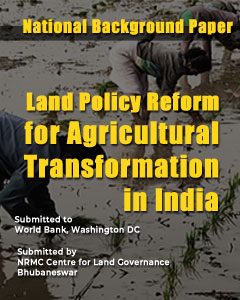Project Reports

World Bank Study on Land Policy Reform for Agricultural Transformation in India
Given that several states, in India have recently initiated tenancy reforms and/or registered tenant farmers for agricultural benefits, there is an opportunity to distil these lessons and share them with states that are still lagging in this aspect. The World Bank Group’s The Agriculture and Food Global Practice has initiated a study on Land Policy Reform for Agricultural Transformation in India which is being conducted by the NRMC Centre for Land Governance.
The study looks at how land policy reforms and interventions, particularly around tenancy and land records, influence access to agricultural benefits and support rural economic growth, more specifically how agricultural transformation process can ensure inclusion of tenants, women farmers and dalits.
The study delivers following outputs:
National Background Paper and initial findings
State Reports
Case Studies
It may be noted that both these documents in no way present the opinion and neither the endorsement of the World Bank and the NRMC Centre for Land Governance at this stage.

STATE OF LAND REPORT
Published by: Center For Land Governance
Contributors: Daksh, ISB, NCAER, NRMC, PR Index
Pages: 87

Effective Mapping Protocol for Forest Rights Mapping in India
Published by: Center For Land Governance
Contributors: Cadasta Foundation, FES, NRMC
Pages: 4
